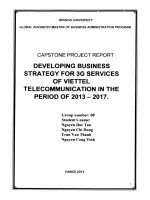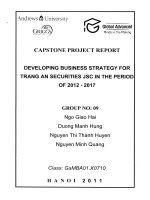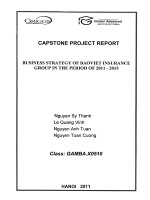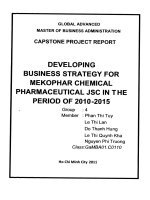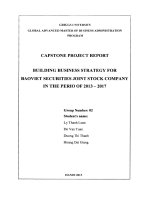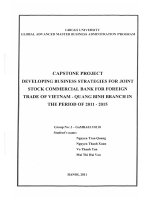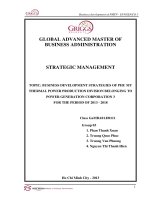Formulating business strategy for SHB Quang Ninh in the period of 2013 - 2018
Bạn đang xem bản rút gọn của tài liệu. Xem và tải ngay bản đầy đủ của tài liệu tại đây (1.34 MB, 120 trang )
FORMULATING BUSINESS
STRATEGY FOR SHB QUANG NINH
IN THE PERIOD OF 2013 - 2018
CAPSTONE PROJECT REPORT
Ho Chi Minh City
Group No.: 6
1. NGUYEN ĐUC VIET (LEADER)
2. NGUYEN THI LAN ANH
3. NGUYEN HONG THU
4. NGUYEN KIM ANH
Class: GAMBA.M0111.
ACKNOWLEDGEMENT
In the process of completing this Capstone Project, Group 6 has received
valuable support and help from several people, organizations and enterprises.
First and foremost, we would like to express our sincere appreciation to
ETC, Vietnam National University Hanoi, Griggs University for providing us with
dedicated help to finish our challenging course and complete our Capstone Project.
Particularly, we would like to express our deepest gratitude to our professors and
lecturers for giving us valuable lectures with all their hearts. Special thanks should
go to Ass. Prof. Arthur Gogatz and Ass. Prof. Dr. Vu Thanh Hung for imparting us
the knowledge of Strategic Management and instructing us to complete the
Capstone project in order to achieve high academic results.
Last but not least, we also sincerely thank Saigon Hanoi Commercial Joint
Stock Bank - Quang Ninh for supporting us in collecting data to complete the
Capstone project. Sincere thanks should also go to our companies and
organizations for creating favorable conditions for us to participate in the program.
Members of Group 6
STATEMENT OF AUTHORSHIP
The members of Group 6 – Class: GaMBA.M0111 hereby commit that:
1. The selection of Saigon-Hanoi Commercial Joint Stock Bank (SHB), Quang Ninh
Branch as the subject for this project has been made upon the approval of the
Management Board of SHB Quang Ninh
2. The completion of this Capstone project is attributed to the efforts of every
member of the team, through data collecting, field study, application of theories,
and other sources of references.
3. This Capstone project has never been used as submission to any research or
training programs.
4. The Group shall take full responsibility for any authorship conflict arisen by the
contents of this project.
Hanoi, November 12
th
, 2012
Members of Group 6:
Nguyen Hong Thu………………………………………
Nguyen Thi Lan Anh……………………………………
Nguyen Kim Anh……………………………………….
Nguyen Duc Viet………………………………………
Strategic Management – Group 6. GaMBA.M0111
- 1 -
TABLE OF CONTENTS
LIST OF TABLES 4
LIST OF FIGURES 4
LIST OF ABBREVIATIONS 5
INTRODUCTION 7
I. The necessity of the research 7
1. General context 7
2. The necessity of the research 7
3. The meaning of the reseach 9
II. Research objectives 9
III. The object and scope of the reseach 9
1. Research subject 9
2. Research methodology 9
IV. Structure of the capstone project 10
CHAPTER 1 : 11
THEORETICAL BACKGROUND FOR BUSINESS STRATEGY DEVELOPMENT 11
1.1. OVERVIEW OF BUSINESS STRATEGY 11
1.1.1. The concepts of strategy 11
1.1.1.1. The concepts of strategy and business strategy 11
1.1.1.2. Characteristics of business strategy 16
1.1.2. Levels of business strategy 16
1.1.2.1. Key issues in business strategy 17
1.1.2.2. Roles of business strategy 17
1.1.3. Factors influencing a company’s business strategy 17
1.1.3.1. External environment analysis 18
1.1.3.2. Internal environment analysis 23
1.2. BUSINESS STRATEGY FORMULATION AND SELECTION 27
1.2.1. Formulating and selecting business strategies - using SWOT. 28
1.2.1.1. Formulating business strategies - using SWOT. 28
1.2.1.2. Selecting business strategies 29
1.2.2. Tools for developing business strategies 29
1.2.2.1. SWOT Matrix 29
1.2.2.2. SPACE Matrix 30
1.2.2.3. Quantitative strategic planning matrix (QSPM). 31
CHAPTER II. 33
ANALYSIS OF THE ACTUAL SITUATION - ENVIRONMENT - BUSINESS STRATEGY
OF SAIGON HANOI COMMERCIAL JOINT STOCK BANK QUANG NINH BRANCH 33
(SHB QUANG NINH) 33
2.1 GENERAL INTRODUCTION OF SAIGON - HANOI COMMERCIAL JOINT STOCK
BANK AND SHB QUANG NINH BRANCH. (SHB Quang Ninh) 33
2.1.1. Overview of Saigon- Hanoi Commercial Joint Stock Bank (SHB) 33
Strategic Management – Group 6. GaMBA.M0111
- 2 -
2.1.2. Overview of SHB Quang Ninh Branch 35
2.1.2.2. Organizational structure of SHB Quang Ninh Branch 36
2.2.2.3. Products and services of SHB Quang Ninh: 37
2.2.2 Analysis of micro environment - industry environment 43
2.2.2.1 Threat of new competitors 43
2.2.2.2 Bargaining power of suppliers 44
2.2.2.3 Bargaining power of buyers (customers): 45
2.2.2.4 Threat of substitute products and services 45
2.2.2.5 Intensity of rivalry within the industry 46
2.2.3 Evaluation of opportunities and threats of SHB Quang Ninh. 51
2.2.4 The external factor evaluation matrix (EFE) of SHB Quang Ninh 55
2.2.5. The competitive profile matrix of SHB Quang Ninh 58
2.3. INTERNAL ENVIRONMENT ANALYSIS 63
2.3.1. Internal forces 63
2.3.1.1 Administration ability 63
2.3.1.2. Network system 64
2.3.1.3. Customer network: 65
2.3.2. Marketing capability 65
2.3.3. Products and services 66
2.3.4. Human resources 66
2.3.5. Physical factors 68
2.3.6. Banking technology 68
2.3.7. Analysis of SHB Quang Ninh’s internal resources through its business
performance 69
2.3.8. Evaluation of SHB Quang Ninh’s strengths and weaknesses 78
2.3.9. The internal factor evaluation (IFE) matrix of SHB Quang Ninh 81
2.4. THE NEED FOR BUSINESS STRATEGY FORMULATION OF SHB QUANG NINH
83
CHAPTER III 86
BUSINESS STRATEGY FORMULATION FOR SAI GON – HANOI JOINT STOCK
COMMERCIAL BANK - QUANG NINH BRANCH 86
IN THE PERIOD OF 2013 – 2018 AND IMPLEMENTATION SOLUTIONS 86
3.1. SHB QUANG NINH‟S BUSINESS GOALS IN 2013 - 2018 86
3.1.1. The SHB system’s vision and goals 87
3.1.2 SHB Quang Ninh’s strategic goals. 87
3.1.2.1 Overall goals 87
3.1.2.2 SHB Quang Ninh‟s specific objectives 88
3.2. ESTABLISHING MATRICES AND SELECTING BUSINESS STRATEGIES OF SHB
QUANG NINH IN THE PERIOD OF 2013 - 2018 89
3.2.1. The SWOT Matrix of SHB Quang Ninh 89
3.2.2. The SPACE Matrix of SHB Quang Ninh 92
3.2.3. The QSPM of SHB Quang Ninh 93
3.2.3.1. Developing alternative strategies 93
3.2.1.2. Determining the optimal business strategy for SHB Quang Ninh in the period
of 2013 - 2018 95
3.3. STRATEGY IMPLEMENTATION SOLUTIONS 100
3.3.1. Organizational structure improvement after the merger. 100
Strategic Management – Group 6. GaMBA.M0111
- 3 -
3.3.2. Human resource training and development after the merger 103
3.3.3. Comprehensive development and completion of the bank’s information technology
system 104
3.3.4. Diversification of products and services, investment in infrastructures and human
resources, implementation of card service development strategy 104
3.3.5. Cross-border payment service development solutions 105
3.3.6. Service quality improvement 106
3.3.7. Marketing solutions: 106
3.3.8. Implemenation budget 111
3.4. RECOMMENDATIONS 111
CONCLUSIONS 113
REFERENCES 114
APPENDICES 115
Strategic Management – Group 6. GaMBA.M0111
- 4 -
LIST OF TABLES
Table 1.1
External Factor Evaluation Matrix (EFE)
Table 1.2
Competitive Profile Matrix (CPM)
Table 1.3
Internal Factor Evaluation Matrix (IFE)
Table1.4
SWOT Matrix
Table 1.5
Quantitative Strategic Planning Matrix
Table 2.1
Market shares in terms of operating targets of SHB Quang Ninh over
years
Table 2.2
Comparison of market shares of SHB Quang Ninh and branches of state-
owned commercial banks (30/09/2012)
Table 2.3
Comparison of market shares of SHB Quang Ninh and branches of some
joint stock commercial banks (30/09/2012)
Table 2.4
The EFE Matrix of SHB Quang Ninh
Table 2.5
Comparison of SHB Quang Ninh‟s capital nobilization and usage with
those of 4 state-owned commercial banks
Table 2.6
Comparison of SHB Quang Ninh‟s capital nobilization and usage with
those of 4 joint stock commercial banks
Table 2.7
The Competitive Profile Matrix of SHB Quang Ninh and state-owned
commercial banks
Table 2.8
The Competitive Profile Matrix of SHB Quang Ninh and joint stock
commercial banks
Table 2.9
SHB Quang Ninh‟s capital mobilization structure
Table 2.10
Outstanding loans over time
Table 2.11
Classification of debt quality
Table 2,12
Service activities of SHB Quang Ninh
Table 2.13
Some financial indicators of SHB Quang Ninh
Table 2.14
The IFE Matrix of SHB Quang Ninh
Table 3.1
The SWOT Matrix of SHB Quang Ninh
Table 3.2
The SPACE Matrix of SHB Quang Ninh
Table 3.3
The QSPM of SHB Quang Ninh
Table 3.4
Strategy implementation budget of SHB Quang Ninh
LIST OF FIGURES
Figure 1.1
Strategic management process
Figure 1.2
M. Porter's 5 Forces Model
Strategic Management – Group 6. GaMBA.M0111
- 5 -
Figure1.3
Strategy development process using SWOT Matrix
Figure 1.4
Strategic Position & Action Evaluation Matrix (SPACE)
Figure 2.1
Organizational chart of SHB Quang Ninh
Figure 2.2.
Pie chart showing the market share of capital mobilization of SHB QN
Figure 2.3.
Pie chart showing the market share of capital usage of SHB QN
Figure 3.1
The SPACE Matrix of SHB Quang Ninh
LIST OF ABBREVIATIONS
ATM
Automated teller machine
APEC
Asia-Pacific Economic Cooperation
CA
Competitive Advantage
ES
Enviroment Stability
EFE
External Factor Evaluation (Matrix)
EU
European Union
FS
Financials Strengths
GDP
Gross Domestic Product
IS
Internals Strenghts
IFE
Internal Factor Evaluation (Matrix)
IE
Internal-External(Matrix)
CPM
Competitive Profile Matrix
KPIs
Key Performance Indicators
QSPM
Quantitative Strategic Planning Matrix
ROA
Return On Assets
ROE
Return On Equity
SHB
Sai Gon - Ha Noi Commerical Join Stock Bank
SWOT
Strengths, Weaknesses, Opportunities, Threats
SO
Strengths, Opportunities
ST
Strengths, Threats
SPACE
Strategic Position & ACtion Evaluation (Matrix)
WO
Weaknesses, Opportunities
WT
Weaknesses, Threats
WTO
World Trade Organization
BIDV
Joint Stock Commercial Bank for Investment and Development of
Vietnam
Vietcombank
(VCB)
Joint Stock Commercial Bank for Foreign Trade of Vietnam
Vietinbank
Vietnam Joint Stock Commercial Bank for Industry and Trade
Techcombank
Vietnam Technological and Commercial Joint Stock Bank
MSB
Vietnam Maritime Commercial Joint Stock Bank
Strategic Management – Group 6. GaMBA.M0111
- 6 -
ACB
Asia Commercial Joint Stock Bank
MB
Military Commercial Joint Stock Bank
Agribank
Vietnam Bank for Agriculture and Rural Development
VIB
Vietnam International Commerical Joint Stock Bank
EXIMBANK
Vietnam Export – Import Commercial Joint Stock Bank
VND
Vietnamese Dong
QN
Quang Ninh Province
VINACOMIN
Vietnam National Coal and Mineral Industries Group
Strategic Management – Group 6. GaMBA.M0111
- 7 -
INTRODUCTION
I. The necessity of the research
1. General context
In recent years, thanks to the renovation policy of the Party, our country's economy
has experienced rapid,solid and powerful development steps. In order to promote the
country‟s industrialization and modernization, there is an inevitable way which is to apply
the world‟s advanced achievements of technological and social science to the specific
circumstances of Vietnam.
The experience of many countries shows that applying the achievements of
technological and social science in general and management science in particular is the key
factor which is highly efficient for the development process of economy in general and
businesses in particular.
The year of 2012 has witnessed dramatic changes in the world‟s economy as well as
Vietnam‟s economy with many signs of economic depression. Political crises in Africa and
the Middle East area (Asia) have led to a decline in commerce, service and investment
activitiesall over the world. The forecasts of the world's economic growth targets in 2012
have been all adjusted lower than those of the previous forecast. Prices of oil, gold and food
continue to increase; inflation is occuring in many countries at different levels. These
situations make a huge impact on Vietnam's economy in 2012 and the following years.
In the context of these economic happenings, the operation of the commercial bank
system in Vietnam is facing major risks and challenges; at the same time, it also
experiences significant changes and fluctuations. In accordance with the Party‟s policies and
the state law, the State Bank of Vietnam has launched several measures as well as issued a
number of regulations,aimed at strengthening and makingbusiness activities of the bank
system healthier. The consolidation or merger between banks is encouraged and supported
by the Government and the State Bank in order to move towards a healthier banking system,
capable of serving public and competing with banks in the area.
2. The necessity of the research
Commercial bank is a financial intermediary which plays an important role as the
bridge between the actors in the economy. In order for banking activities to be effective,
Strategic Management – Group 6. GaMBA.M0111
- 8 -
management activities are required to be scientific, methodical and systematic. Therefore,
strategic management is one of the leading tasks of many banks.
Saigon – Hanoi Commerical Joint Stock Bank which has been stranformed from the
rural joint stock form into the urgan one recently, is a young commercial banks in Vietnam
with limited basic conditions such as charter capital, banking technology, management
experience and human resources. Thus, in order to improve its position, enhance its
competitiveness and gradually dominate the market for modern banking services, it is
required that Saigon – Hanoi Commerical Joint Stock Bank should have an appropriate
business strategy.
Saigon - Hanoi Commercial Joint Stock Bank - Quang Ninh Branch (SHB Quang
Ninh) is a subordinate branch of Saigon Hanoi Commercial Joint Stock Bank (SHB) with
limited basic conditions such as capital, banking technology, management experience and
human resource compared with other state-owned banks. In addition, the merger between
Hanoi Building Commercial Joint Stock Bank (HBB) and SHB also requires SHB to develp
and adjust the entire business strategy for the coming time. Therefore, in addition to the
purposes of improving its position, enhancing its competitiveness and gradually dominating
the market for modern banking services; restructuring and reorganizing the organizational
apparatus as well as directing the business strategy of the whole system requires SHB to
have an appropriate business strategy.
SHB Quang Ninh is not an exception. SHB Quang Ninh includes HBB Quang Ninh,
therefore it has to develop and adjust its own business strategy consistent with the whole
system‟s general provisions on mergers and restructuring as well as the specific
characteristics of Quang Ninh- a province located in the Northern triangle economic zone of
the country.
Starting from the above rationales along with the desire to apply the knowledge
gained from theGlobal Advanced Master of Business Administration program of Griggs
University to the real practices of Vietnamese enterprises, after discussing and exchanging
ideas, members of Group 6 –GaMBA.M0111 has unanimously selected the research topic:
"Formulating business strategies for Saigon Hanoi Commerical Joint Stock Bank –
Quang Ninh Branch in the period of 2013 - 2018".
Strategic Management – Group 6. GaMBA.M0111
- 9 -
3. The meaning of the reseach
The research will develop a business orientation for the 5-year period from 2013 to
2018 and the following years. It sets a clear goal which is widely shared by the whole Bank
and allfunctional departments; at the same time, it also specifies the resources available for
the implementation process.
This strategy is also the common goal of all SHB Quang Ninh staff.
Finally, the research performs thorough analysis of the environment, potential risks
and competitive advantages to clearly identify the advantages and potential which can be
transferred to real power of SHB Quang Ninh.
II. Research objectives
The major objectives of the research are:(1)Systematizethe theoriesofbusiness
strategy, (2) Analyzethecurrent business situation ofSaigon Hanoi Commercial Joint Stock
Bank – Quang Ninh Branch in the period of 2010–2012and (3) Proposebusiness strategiesfor
the periodof 2013 - 2018, at the same timesuggest some implementation solutions.
The firstimportant taskof the researchis to
studythegeneraltheoriesofcommercialbankbusiness strategy and select strategic
managementmodelsfor analysis.Based on thesemodels, theresearchwill assessthe current
business situation of SHBQuangNinhin the periodof 2010-2012. Finally, theresearch will
proposebusinessstrategiesfor SHBQuang Ninhin theperiodof 2013 - 2018basedonthe
abovestandardmodelsandtheresultsfromthe situation analysis ofthebank.
III. The object and scope of the reseach
1. Research subject
Research subject:
Research the related issuesin the business strategy development process arising
in the actual situation of SHB Quang Ninh.
Scope of the research:
Spatial range: Saigon Hanoi Commercial Joint Stock Bank – Quang Ninh
Branch
Time range: During the period of 2010 - 2012
2. Research methodology
- Systematic method: Assessall the factorsthatcanaffectSHBQuang Ninh‟s strategy.
Withthismethod, the assessment offactorsaffectingthe bank‟s strategy includes both external
and internal environment of SHB Quang Ninh.
Strategic Management – Group 6. GaMBA.M0111
- 10 -
- Secondary data analysis method: This method is usedto study thetheoretical
backgroundforthedevelopmentofbusiness strategy.
- Primary data analysis method: AssesstheactualsituationofSHBQuang Ninhin thebusiness
strategy formulationandimplementation process.
-Quantitative method: Thismethod isusedto select strategies and makedecisions.
- Strategic analytical method: Such asSWOTMatrix analysis, QSPM analysis.
IV. Structure of the capstone project
In addition to the Table of contents, Introduction and List of references, this report
includes three following chapters:
Chapter 1: Theoretical background for business strategy development
Chapter 2: Analysis of the actual business situation of Saigon Hanoi Commercial
Joint Stock Bank – Quang Ninh Branch
Chapter 3: Business strategy development for Saigon Hanoi Commercial Joint Stock
Bank – Quang Ninh Branch in the period of 2013 – 2018: Implementation solutions,
Recommendations and Conclusions.
Strategic Management – Group 6. GaMBA.M0111
- 11 -
CHAPTER 1 :
THEORETICAL BACKGROUND FOR BUSINESS STRATEGY DEVELOPMENT
1.1. OVERVIEW OF BUSINESS STRATEGY
1.1.1. The concepts of strategy
1.1.1.1. The concepts of strategy and business strategy
1.1.1.1.1. Definitions of strategy
In the history of business management, there have many views of"Business
Strategy"by different authors; we can consider some definitionsofbusiness
strategytoidentifyitscharacteristics.
According to Chandler (1962), strategy is “the determination of the basic long-
term goals and objectives of an enterprise, and the adoption of courses of action and
the allocation of resources necessary for carrying out these goals”(Chandler, Alfred
D., Jr , 1962, Strategy and Structure. Cambridge, MA: MIT Press).
In thebookExploringCorporateStrategy,the two authors -
JohnsonandScholesdefinestrategyas follows: “Strategy is the direction and scope of an
organisation over the long term, which achieves advantage for the organisation
through its configuration of resources within a changing environment and to fulfil
stakeholder expectations”(Johnson, G., Scholes, K(1999).
ExploringCorporateStrategy. 5thEd. PrenticeHallEurope)
Until the 1980s, James B Quinn came up with a more general definition of
strategy as follows: “Strategy is the pattern or plan that integrates an organization’s
major goals, policies and action sequences into a cohesive whole”(Quinn, J., B. (1980)
Strategies for Change: Logical Inscrementalism. Homewood, Illinois, Irwin).
In the opinion of Michael Porter, "Strategy is the art of building solid
competitive advantages to defense"
The word “strategy” can be construed in many ways. Minzberg summarizes the
meanings of the word “strategy” which have been used by many scholars to suggest
"5P" of strategy: Plan, Ploy, Pattern, Position, Perspective.
From the abovedconcepts, it can be seen:
Strategy is associated with an enterprise‟s goals and the formulation of business
strategy is to help the enterprise achieve those set goals.
Strategic Management – Group 6. GaMBA.M0111
- 12 -
Strategy is not a separate action but a series of cohensive actions and decisions
and all strategies must aim at achieving an enterprise‟s goals and objectives. Strategy is
developed on the basis of the enterprise‟s internal resources and external factors that
affect the enterprise.
To achieve this, the enterprise shouldcreate the consistency of all activities in
order to create and maintain competitive advantages in the long term.
In short, a general definition of strategy can be given as follows:“Strategy is a
coordinated series of actions which involve the deployment of resources to which one
has access for the achievement of a given purpose” or in other words "Business
strategy is the overall decisions and activities related to the choice of means and
allocation of resources to achieve the set goals. In a competitive environment, an
important goal of enterprises is to achieve a better strategic position compaired with
other competitors".
1.1.1.1.2. Definitions of business strategy
From the mid-20th century, the term "strategy" has been widely used in both
macro-economics and micro-economics. In the macro aspect, it refers to basic,
comprehensive and long-term development plans of sectors, industries or regions
In terms of micro management, strategies also aim at development which is
closely associated with business. So, in the business environment, people often talk
about the term "business strategy" of a company.
In business world, resources are always limited and the business environment is
volatile, while enterprises have to face fierce competition from rivals. Competing in the
market is similar to fighting on the battlefield.
Business strategy provides long-term orientation and valuable guidelines for a
company and its functional departments. There are different definitions of business
strategy:
- Business strategy of an enterprise is a general course of actions towards
achieving the enterprise‟s goals. Strategy is a set of goals and policies as well as major
plans to achieve those goals.
- An enterprise's business strategy is the optimal choice of combining measures
(using the enterprise‟s resources), time (opportunities, threats) and space (business
field, area of operations) in accordance with business environment analysis and the
Strategic Management – Group 6. GaMBA.M0111
- 13 -
enterprise's resources in order to achieve basic and long-term objectives consistent with
the vision of that enterprise(Nguyen Khoa Khoi, Dong Thi Thanh Phuong, Strategic
Management , Statistics Publishing House).
Here is a definition that has been used in MBA programs: business strategy is a
series of commitments and actions that a company uses to win a competitive advantage
by exploiting its core competencies on a particular market (associated with a product
or a product line).
1.1.1.1.3. Definition of strategic management
a. Strategic management
Strategic management can be defined as the art and science of formulating,
implementing and evaluating cross-functional decisions that enable an organization to
achieve its objectives (Fredr. David, Concepts of strategic management- Statistics
Publishing House, 2006)
As this definition implies, strategic management focuses on integrating
management, marketing, finance/accounting, production/operations, research and
development, and business information systems to achieve organizational success.
b. Strategic management process
Strategic management is the process of studying the current, as well as future
environments; establishing goals of an organization; setting, implementing and
monitoring the implementation of decisions in order to achieve those goals in the
current and future environments.
Strategic Management – Group 6. GaMBA.M0111
- 14 -
Figure 1.1. Strategic management process
c. Vision, mission statements and core values
- Vision
Strategic vision isthehighestaspirationofbusiness ownersabout the future
oftheirbusiness.
Speaking of vision, itis describingthefuturewithsomespecialmethodsthatmakeitbetter
than the reality. Establishing a business strategic vision hasalwaysbeenamajorchallengefor
any organization.It describesthepeople and theorganizationat theprospecttheywill
achieveinthefuture.
A vision usually starts from the things that leaders are most interested in and
committed to achieve. Margaret Thatcher once said, "The responsibility of leaders is to
illuminate the path to the future, and then seek help from everyone to create that
future." A vision is considered to be effective when it includes the following features:
Company’s functions, duties&strategic
objectives (1)
Company’s internal
analysis (S, W) (3)
External environment
analysis (O, T) (2)
Business strategy selection (4)
Corporate - level strategy (5)
Business – level strategy
Functional – level strategy
Strategy implementation (6)
Performance measurement &
evaluation (7)
Feedback
Strategic Management – Group 6. GaMBA.M0111
- 15 -
- Be inspiring: vision statements need to have an impact on employees both
mentally and emotionally.
- Clear and vivid: if you can „see‟ a strategic vision in business as a vivid
picture, you will earn yourself a better chance to achieve it.
- Envisioning a better future: Leaders must help employees to see what they
would have if they reach that vision. Employees will always be linked to the vision
when they see the benefits that they will have when achieving that vision.
- Mission statements
A company's mission is a concept used to determine the company‟s purposes,
the rationalesfor which the company exists and the basis for its development. A
company's mission statements are its proclamation to the society; it demonstrates the
values and meaning of the existence of the company to the society.
Basically, a company's mission statements are merely to clarifyacrucialissue: “what
is the purpose of its business?”. The scopeof the missionstatement is oftenrelatedto the
products, markets, customers, technology andphilosophiesthat the company is pursuing. So
it can be said that missionstatements clarify the meaning of theexistence of an organization,
what it wantstobe, thecustomers it wantstoserve, theway it wants to operate.
- Core values
A company‟s core values are what the company consider as priceless and
unchangeable. Core values create a foundation for the company‟s internal regulations.
+ Core values are defined as follows:
- A belief system that affect behaviors between human and human, or between groups
of people.
- Core values are the "soul" of an organization
- Effective values that are deeply rooted in an organization
- Core values help shape organizational psychology, which can support or reduce
individual psychology.
+ Core values are the essential and long-term guidelines and rules:
- They help orient the decisions and actions of an organization
- They are not cultural actions or specific activities
- They are not built for the purpose of profit or other short-term interests
Strategic Management – Group 6. GaMBA.M0111
- 16 -
- Organizations want to retain their core values even when its mission has
changed.
- They are essential and long-term principles of an organization - a set of tiny
guiding rules that have profound impacts on the way that the people in that
organization think and act.
- Core values are not affected by public opinions, but have intrinsic values and
great importance to those inside the organization. Core values are some of the very rare
guiding rules that have enormous influences. They are the soul of an organization, the
values that guide all actions.
- Core values have depth and they are extremely important values. These values
are rarely changed by market changes. On the other hand, organizations will normally
change the market, if necessary, in order to maintain its core values.
1.1.1.2. Characteristics of business strategy
Business strategy determines the basic objectives and business direction of a
business in a specific period.
The orientation characteristic of business strategy is to ensure the continuous and
sustainable development of a business in the constantly fluctuating business
environment.
Business strategy ensures maximum mobilization and optimal combination of the
extraction and use of a business‟s resources at the present and in the future. It also
promotes the strengths and seizes the opportunities to gain competitive advantages.
Business strategy of an enterprise is reflected throughout a continuous process.It is
often developed in a long period of time (3, 5 to 10 years).
Business strategy always has attacking thoughts in order to win in the marketplace.
1.1.2. Levels of business strategy
Depending ondifferent viewpoints, exact strategiclevels can be identified. However,
most commonly, strategyisdividedintothreelevels:
- Corporate-level strategy: towardstheoverallpurposeandscopeof an
organization.Itidentifiesthe actions thatthecorporatetakes inordertogaina competitive
advantageby selecting, managing a group
ofdifferentbusinesses,competinginanumberofindustriesandproduct markets.
Strategic Management – Group 6. GaMBA.M0111
- 17 -
- Business-level Strategy: the overallcommitmentsandactionsthat helpbusinessesgaina
competitive advantageby exploitingtheircore competenciesinspecificproductmarkets. It
reflects theconfidenceof a business in the locationandthe way itcan gaina competitive
advantageoveritscompetitors. The importance ofbusinessstrategyisto allow a business
to"decide to perform activities differently or perform different activities as compared to its
rivals”
- Functional-level strategy: helps implement effectively corporate-levelandbusiness-
level strategies bythecomponentsin terms ofresources, processes, people and necessary
skills. This is the strategytoimprovetheeffectiveness ofbasic activitiessuchasproduction,
marketing, materialsmanagement, research and development
1.1.2.1. Key issues in business strategy
A business strategy must address three following key issues:
- Who will be served?
- What needs will be satisfied?
- How will those needs be satisfied?
1.1.2.2. Roles of business strategy
Firstly, business strategy helps enterprises understand and take advantage of
business opportunities to formulate appropriate strategies and development policies in
order to accomplish the set goals.
Secondly,business strategy helps managers forecast uncertainties and risks
occuring in the present and in the future; thereby adopt appropriate policiesin order to
initiatively response to those uncertainties and risks.
Thirdly, business strategy helps managers efficiently use and effectively
allocate the enterprise‟s available resources .
Fourthly, business strategy helps managers effectively coordinate the
organization‟s functions to reach the common goals.
1.1.3. Factors influencing a company’s business strategy
The strategic management process of an enterprise is divided into four phases:
Strategic Planning =>Strategy Implementation=> Control => Strategy adjustment.
This process is influencedbymany factors whichcan be divided intotwogroups:
external environmentandinternalenvironment. Ineachtype of environment, there are
factorsthatdirectlyinfluencean enterprise‟s strategy.In fact, these factorsare always
Strategic Management – Group 6. GaMBA.M0111
- 18 -
changing and closely interactingwitheachother, creatingopportunitiesandrisks thatan
enterprise may encounter. Thus,evaluating theexternal environmentisastep in the
strategy formulation process; it helps enterprises takeadvantageofopportunitiesand
avoid risks brought by the external environment.
1.1.3.1. External environment analysis
1.1.3.1.1. Analysis of influencing factors
This is the group of factors that create opportunities and threats that enterprises
may face in a competitive condition. The external environmental factors are classified
into two major groups, including the macro environment and micro environment.
A. Macro environment (PEST Model)
(1) Economic environment
This segment determines the health and prosperity of an economy, it always
make significant impacts on enterprises and industries. It refers to the nature and
development direction of an economy in which enterprises are operating.In fact,
enterprises, especially banks usually pay attention to these economic factors through
various economic variables such as: GDP growth trend, inflation, interest rates, the
availability level of the credit system, the level of disposable income and
consumptiontrends of citizens.
(2) Technological environment
Inaspreadinganddiverse space, technological changesaffectmanyaspectsof
asociety.Forbanking operations, technology can
allowbankstoprovidethebestofmodernbankingservices.
(3) Social-cultural environment
This segment is related tosocialattitudesandculturalvalues. Similar
totechnologychanges, socialchangesalsocreateopportunitiesandthreats, ascultural
valuesandsocialattitudesmakeupthe foundation ofa society. Therefore, these
changesoftenlead tothe changes intechnological, political-legal,
economicanddemographic conditions.
(4) Demographic environment
The demographic segmentin themacroenvironment isrelated topopulation,
agestructure, geographic distribution, ethniccommunities, andincome distribution.
(5) Political – legal enviroment
Strategic Management – Group 6. GaMBA.M0111
- 19 -
This environment has a major impact on the level of environmental
opportunities and threats. Banks must always carefully analyze the new philosophies
andpolicies related to banking activities such as: interest rate policy, exchange rates,
foreign exchange management, tax, debt management
(6) Global environment
This environment includes relevant global markets, current changing markets,
important international political events, basic institutional and social characteristics of
the global market.
B. Macro environment – Industry environment
The Five Forces Model was introduced by Michael E. Porter – a professor at
Harvard Business School and becamea popular strategic model used by many
corporate strategists. According toMichaelE.Porter, there arefive forces that determine
the competitionin a particular industry. They are:(1) threat of new entrants, (2)
bargaining power ofsuppliers, (3) bargainingpowerofbuyers, (4) threatofsubstitute
products, and(5)industry competitor
Figure 1.2. M. Porter's 5 Forces Model
(1) Threat of new entrants
New competitors when entering the marketoften create new competition by
taking the market share from existing firms. Normally, when entering a new
industry,new entrants face certain barriers such as: the econmies of scale, product
Potential Entrants
INDUSTRY
COMPETITORS
Rivalry among
Existing firms
Buyers
Suppliers
Substitutes
Threat of Substitute Products or
Services
Bargaining
Power
of Buyers
Threat of new entrants
Bargaining
Power
of Suppliers
Strategic Management – Group 6. GaMBA.M0111
- 20 -
differentiation, capital requirements, cost advantages, access to distribution channels,
the Government‟s regulations,
(2) Bargaining power of suppliers
Suppliers can claim their power and threaten producers by increasing prices, reducing
the quantity and quality of products/services. For banks, suppliers are depositors and
whose power is reflected by the amount of capital they can deposit. Thus, they can
show their power by setting the price/interest rate.
(3) Bargaining power of buyers
Buyers often ask for discounts ordemandhigher quality of products and services,
switch to other providers if necessary. For banks, buyers are the people who use the
banking products and services. Power of buyers is usually expressed by the scale of
products and services that they use. Hence, they also have the right to negotiate with
banks on the price of products and services
(4) Threat of substitutes
Substitute products may limit the development potential or profits of an
industry. In the banking industry, substitute services are considerably rare. However,
to some extent, it still appears new markets and customer trends. Instead of using
traditional bank servicessuch as savings and loans, customers may have different
choices, for example: investing in the stock market or real estate instead of
openingsavings accounts.
(5) Intensity of rivalry among competitors
The competition within an industry is reflected by the fact that competitors use
their power to attract customers. Commonly used techniques are price competition,
product introduction, marketing campaigns and advertising programs. The intensity of
competition within an industry depends on factors such as: the number of competitors,
industry growth rate, high fixed costs or perishable products, the level of product
standardization and the barriers to exit.
In fact, when analyzing the industry environment and competition environment,
strategists often answer four questions: (1) what is the scope of the industry in which the
company is operating?, (2) what is the structure of the industry?, (3) which companies are
the competitors?, (4) what are the criteria to determine the competitors?.
Strategic Management – Group 6. GaMBA.M0111
- 21 -
1.1.3.1.2. External factor evaluation matrix
a.External factor evaluation matrix (EFE).
EFE matrix helps managers evaluate external factors, synthesize and summarize
major opportunities and threats from the external environment that can affect the
business. Based on this, business managers can evaluate the response level of the
business to those opportunities and threats.
There are 5 steps to develop an EFE matrix:
Step 1:Make a list of factors including opportunities and threats that influence
the success of the business in the industry.
Step 2:Each factor will be assigned a weight of importance from 0.0 (not
important) to 1.0 (very important). The total value of the weight for all factor‟s level of
importance must be 1.0.
Step 3: Assign a rating between 1 and 4 to each factor that decides the business
success to evaluate how the current business strategy responds to that factor: 4 = the
response is superior, 3 = the response is above average, 2 = the response is average
and 1 = the response is poor;
Step 4: Multiply each factor‟s weightwith its rating to calculate the weighted
score for each factor.
Step 5: Add all weighted score of all factors to identify the total weighted score
for the company.
Evaluation: The total weighted score of the matrix does not depend on the
number of factors listed. The highest total weighted score a business can have is 4.0,
the lowest is 1.0.
If the total weighted score is higher than 3: the business responds positively to
external opportunities and threats
If the total weighted score is higher than 2.5 (and lower than 3): the business has
average ability to respond to external opportunities and threats.
The total weighted score lower than 2.5 reveals that the business responds
poorly to external opportunities and threats.
Strategic Management – Group 6. GaMBA.M0111
- 22 -
Table 1.1. External Factor Evaluation Matrix (EFE)
External business environment factors
Weight
Rating
Weighted score
(1)
(2)
(3)
(4) = (2)x(3)
OPPORTUNITIES
1……………………………………………….
2……………………………………………….
3……………………………………………….
4……………………………………………….
5……………………………………………….
THREATS
1……………………………………………….
2……………………………………………….
3……………………………………………….
4……………………………………………….
5……………………………………………….
Total = 1
Total weighted
score = A
b. Competitive profile matrix (CPM).
This matrix provides visual assessment of the business compared with major
competitors in the industry.The comparison is based on the factors affecting the
competitiveness of companies in the industry.
A Competitive profile matrix can be developed by 5 steps:
Step 1: List all the key success factors of the industry (about 10 factors)
Step 2: Assign a weight for each factor from 0 (not important) to 1.0 (most
important). The sum of all weights should equal 1.
Step 3: Rate each factor ranging from 1 to 4 for all the companies in analysis.
Here,the response is poor represented by the rating of 1, the response is average
represented by 2, the response is above average represented by 3, the response is
superior represented by 4.
Step 4: Calculate the weighted score for each factor by multiplying each factor‟s
rating with its weight.
Step 5: Calculate the total weighted score for each company by adding all the
weighted scores of this company.
Evaluation: Compare the total weighted score of the company with that of other
major competitors in the industry in order to evaluate the competitiveness of the
company
